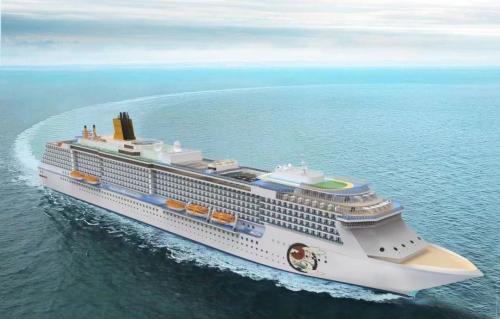First China-made Adora Cruises’ ship to set sail in 2023
China’s push to expand its presence in the cruise ship construction sector is in the spotlight again, with China State Shipbuilding Corporation (CSSC) releasing further details for its joint venture with US-based Carnival Corporation, and also previewing a new luxury cruise ship design. The Chinese government has long seen large cruise ships as part of “the crown jewels” of shipbuilding and considers the full promotion of their design and construction key for the upgrading of the country’s shipbuilding industry.
According to CSSC, China’s first domestically developed cruise liner will be delivered to CSSC Carnival Cruise Shipping, the joint venture between CSSC and Carnival, by the end of this year under the new brand Adora Cruises. The newbuild has been under construction at Shanghai Waigaoqiao Shipbuilding for a number of years, being held back by the Covid pandemic and several lockdowns in China. Based on Fincantieri’s Carnival Vista-class platform, it will be 135,000gt, 323m long, 37m wide, with 2,125 passenger cabins (CSSC has established a separate joint venture with Fincantieri to grant a technology licence of the ship model platform and to provide technical and project service support throughout the shipbuilding process).
The vessel is the first of several, with at least two more new ships in the pipeline and a number of older vessels, such as the Costa Atlantica and Costa Mediterranea, that will be converted to the same Adora Cruises standards. The new brand plans to begin cruising along the ‘Maritime Silk Road’ – a trade route that connects the Chinese mainland with Southeast Asia, India, the Arabian Peninsula, Egypt, and the Mediterranean – as part of an offering of both short and long cruises for both domestic and international travel. It will also call at countries important to China’s ‘Belt and Road’ initiative.
Shanghai Waigaoqiao Shipbuilding has already started design and construction for a second larger 341m-long, 142,000gt cruise vessel – an adaption of the Vista-class platform – which is set to debut in 2025 and in recent weeks the design for a third smaller, more luxurious ship has been given approval in principle (AiP) by China Classification Society (CCS). Developed and designed by CSSC Cruise Technology Development, a subsidiary of CSSC, the 80,000gt vessel is being heralded as an important milestone for CSSC, highlighting its ability to apply key technologies in cruise development.
“The design underlines the R&D work and innovation and green technology advances being made,” says CCS’s Wang Zhirong.
The ship has a total length of 293.5m and a width of 34m, and its design includes a number of enhanced features. In order to enhance energy efficiency, CSSC says it has optimised the aerodynamic and hydrodynamic performance of the vessel’s superstructure and equipped a range of energy-saving devices, helping the ship meet the requirements of the phase three of IMO’s Energy Efficiency Design Index (EEDI).
Positioned as a high-end cruise ship, the comfort level is significantly improved by greatly increasing the passenger space ratio, passenger-crew ratio, and public area per passenger, according to CSSC. The balcony room ratio is expected to exceed 69%.
Whether China’s nascent cruise ship construction sector can ever compete with the established shipyards in Europe, which have achieved their dominance through years of specialisation and the development of local cruise ship building eco-systems, remains to been seen.
Despite the impact of Covid-19, CSSC is extremely bullish on the outlook for the cruise industry for the mid to long term. However, it notes that the development of a domestic cruise industry cannot be successful without a complete and specialised supply chain. Its partnership with Carnival should help with that.
An example of China’s Company Law, which requires foreign businesses to form a joint venture with a local partner in order to expand into the local market, such partnerships typically require the foreign company to transfer propriety methods, designs, and other know-how to the joint venture company. And as local production is often a requirement of these deals, emerging industries, in this case cruise ship construction, receive a major boost in terms of the development of local expertise.
It may take some time, but the Chinese government’s serious commitment to master large cruise ship construction and the country’s developing access to the latest technical and design knowledge could very well see China position itself to take its European counterparts in the decades ahead.




